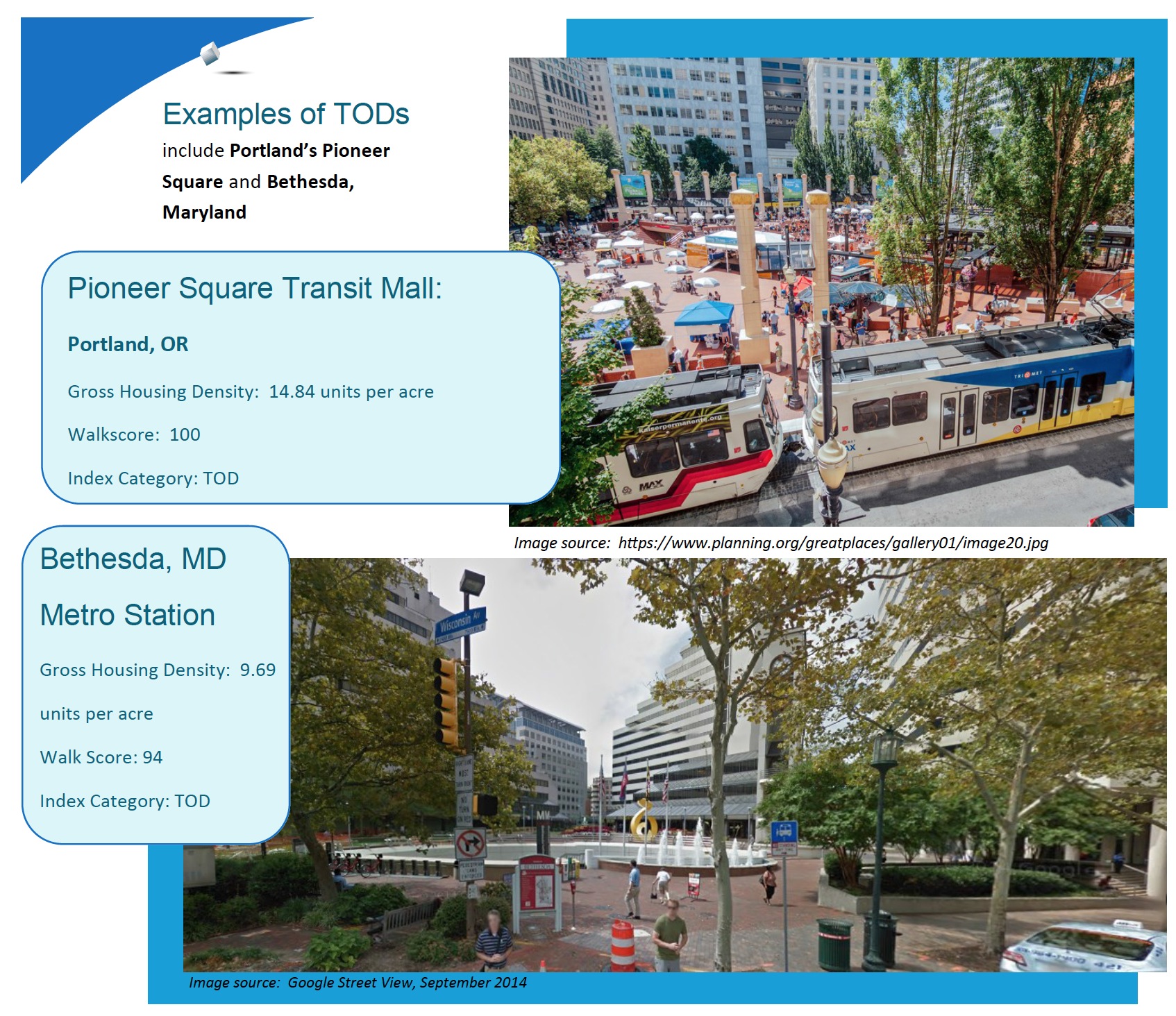THE TOD GROUP
Transit-Oriented Developments (TODs) are defined as walkable, mixed-use and dense communities within a half-mile of a train station while Transit-Adjacent Developments (TADs) refer to station areas that are characterized by low-density, auto-oriented land uses. Research indicates that gross housing densities should be at least 8 units per acre (which equals 4,000 households within an area radiating a half-mile from a train station) in order to support transit ridership. Walkscore.com rates communities with a 70 or greater (out of a possible 100 score) as Very Walkable or a Walker’s Paradise (above 90).
The TOD Index™ provides a new benchmark to track both home and rental values in train station areas across the United States. The TOD Index includes stations categorized as TODs, Hybrids and TADs. Each category is also benchmarked against the national Zillow Home Value Index (ZHVI) or the national Zillow Rent Index (ZRI).
Evaluating the market performance of TODs relative to national trends is of significant value because of the following factors influencing 21st century real estate trends:
- The national housing market has undergone significant shifts following the 2008 recession
- A growing percentage of Americans, including a large percentage of the millennial generation prefer to live in urban areas with high-quality transit access
- Investors, developers, planners and policy-makers are looking to identify metrics to measure the success of TOD across the United States
The TOD Index allows for comparing performance in the for-sale and rental housing markets from the neighborhood to the national scales.
Criteria for Categorizing Station Areas
The United States has approximately 4,000 passenger train stations that are an integral part of serving over 10.7 billion transit trips in the United States in 2013, the highest ridership in 57 years.2 The following criteria are used to classify stations across in the United States along a TOD–Hybrid–TAD spectrum.
1,441 stations across the US are categorized as TOD Stations, which meet the following criteria:
1. Gross housing density must be greater than 8 units per acre across the half-mile station precinct
AND
2. The average Walk Score for the station area must be 70 or greater
TOD Index — Home Values
In August 2014, the average home value in TODs was $518 per sf. The average home value in Hybrids was $251 per sf and the average home value in TADs was $196 per sf. This compares to the average national ZHVI for that same month at $149 per sf. Therefore, the average home in a TOD was worth 3.48 times more than the average home in the United States.
Since 1996, homes in TODs have appreciated about 300% as compared to 168% for Hybrids, 126% for TADs and 103% for the national average. When looking at the data during the most recent economic recovery, which began January 2012, the growth of home values in TODs has significantly out-paced all other categories. During the 32 month period, average home values in TODs has grown by 37%, as compared to 27%, 24% and 20% in Hybrids, TADs, and the national average, respectively. This means that the growth of home values in TODs have out-paced the growth of home values nationally by a margin of 1.85-to-1.
TOD Index — Rental Values
In August 2014, the average apartment in TODs rented for $2.28 per sf. Average rent in Hybrids was $1.36 per sf and the average rent in TADs was $1.19 per sf. This compares to the average national ZRI for that same month at $0.89 per sf. Therefore, the average apartment in a TOD rented for 2.56 times the average rental unit in the United States.
When looking at the data since January 2012, the growth of rent values in TODs has significantly outpaced all other categories. During the 32 month period, average rent values in TODs have grown by 18%, as compared to 13%, 11% and 8% in Hybrids, TADs, and the national average, respectively. This means that the growth of rent prices in TODs has out-paced the growth of rent prices nationally by a margin of 2.3-to-1.
Download full version (PDF): TOD Index
About the TOD Group
www.thetodgroup.com
The TOD Group, LLC is a national leader in Transit Oriented Development (TOD). We create the opportunity for investors to benefit from TOD, which Emerging Trends in Real Estate rates as the top investment in real estate. The TOD Group has expertise in serving as a master developer and consultant to private and public sector entities. Our mission-driven business model focuses on equity-based TOD investments that enable a sustainable future.
Tags: Pedestrian, The TOD Group, TOD, Transit-Oriented Development, Walkability







 RSS Feed
RSS Feed
The index is interesting but it deals with only one end of the trip. Will the train take you to where your want or need to go, when you want to go, in a reasonable amount of time with few if any transfers at a reasonable amount of time and in a reasonable amount of comfort and safety? Or is the index just reflecting the hope that it would do so, if chosen as a mode?